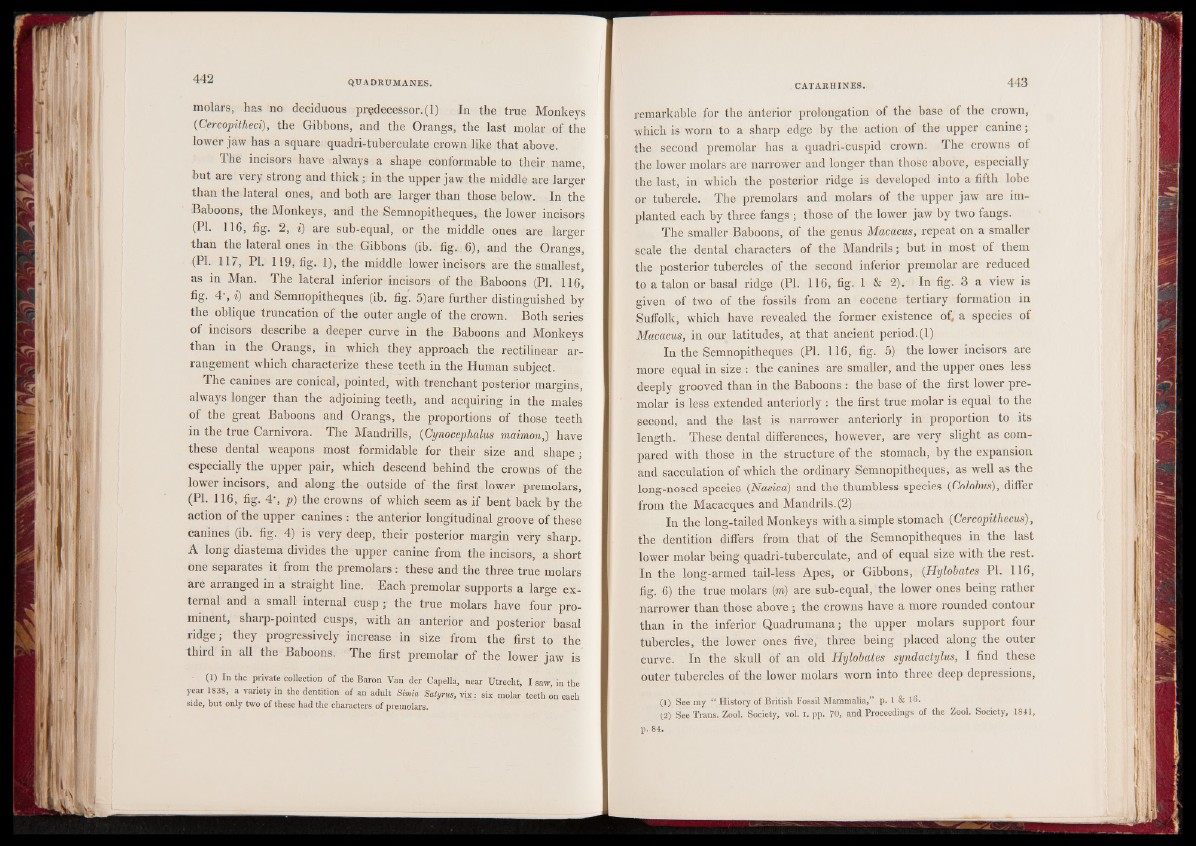
molars, has no deciduous predecessor. (1) In the true Monkeys
(Cercopitheci), the Gibbons, and the Orangs, the last molar of the
lower jaw has a square quadri-tuberculate crown like that above.
The incisors have always a shape conformable to their name,
but are very strong and thick; in the upper jaw the middle are larger
than the lateral ones, and both are larger than those below. In the
Baboons, the Monkeys, and the Semnopitheques, the lower incisors
(PI. 116, fig. 2, i) are sub-equal, or the middle ones are larger
than the lateral ones in the Gibbons (ib. fig. . 6), and the Orangs,
(PI. 117, PI. 119, fig. 1), the middle lower incisors are the smallest,
as in Man. The lateral inferior incisors of the Baboons (PI. 116,
fig. 4-, i) and Semnopitheques (ib. fig. 5)are further distinguished by
the oblique truncation of the outer angle of the crown. Both series
of incisors describe a deeper curve in the Baboons and Monkeys
than in the Orangs, in which they approach the rectilinear arrangement
which characterize these teeth in the Human subject.
The canines are conical, pointed, with trenchant posterior margins,
always longer than the adjoining teeth, and acquiring in the males
of the great Baboons and Orangs, the proportions of those teeth
in the true Carnivora. The Mandrills, (Cynocephalus maimon,) have
these dental weapons most formidable for their size and shape;
especially the upper pair, which descend behind the crowns of the
lower incisors, and along the outside of the first lower premolars,
(PI. 116, fig. 4-, p) the crowns of which seem as if bent back by the
action of the upper canines | the anterior longitudinal groove of these
canines (ib. fig., 4) is very deep, their posterior margin very sharp.
A long diastema divides the upper canine from the incisors, a short
one separates it from the premolars: these and the three true molars
are arranged in a straight line. Each premolar supports a large external
and a small internal cusp ; the true molars have four prominent,
sharp-pointed cusps, with an anterior and posterior basal
ridge; they progressively increase in size from the first to the
third in all the Baboons. The first premolar of the lower jaw is
■ (1) In the private ^collection of the Baron Van der Capella, near Utrecht, I saw, in the
year 1838, a variety in the dentition of an adult.Simla Satyrus, vix: six molar teeth on each
side, but only two of these had the characters of premolars.
remarkable for the anterior prolongation of the base of the crown,
which is worn to a sharp edge by the action of the upper canine;
the second premolar has a quadri-cuspid crown. The crowns of
the lower molars are narrower and longer than those above, especially
the last, in which the posterior ridge is developed into a fifth lobe
or tubercle. The premolars and molars of the upper jaw are implanted
each by three fangs ; those of the lower jaw by two fangs.
The smaller Baboons, of the genus Macacus, repeat on a smaller
scale the dental characters of the Mandrils; but in most of them
the posterior tubercles of the second inferior premolar are reduced
to a talon or basal ridge (PI. 116, fig. 1 & 2). In fig. 3 a view is
given of two of the fossils from an eocene tertiary formation in
Suffolk, which have revealed the former existence of, a species of
Macacus, in our latitudes, at that ancient period. (1)
In the Semnopitheques (PI. 116, fig. 5) the lower incisors are
more equal in size : the canines are smaller, and the upper ones less
deeply grooved than in the Baboons : the base of the first lower premolar
is less extended anteriorly : the first true molar is equal to the
second, and the last is narrower anteriorly in proportion to its
length. These dental differences, however, are very slight as compared
with those in the structure of the stomach, by the expansion
and sacculation of which the ordinary Semnopitheques, as well as the
long-nosed species (Nasica) and the thumbless species (Colobus), differ
from the Macacques and Mandrils. (2)
In the long-tailed Monkeys with a simple stomach (Cercopithecus),
the dentition differs from that of the Semnopitheques in the last
lower molar being quadri-tuberculate, and of equal size with the rest.
In the long-armed tail-less Apes, or Gibbons, (Hylobates PI. 116,
fig. 6) the true molars (m) are sub-equal, the lower ones being rather
narrower than those above ; the crowns have a more rounded contour
than in the inferior Quadrumana; the upper molars support four
tubercles, the lower ones five, three being placed along the outer
curve. In the skull of an old Hylobates syndactylus, I find these
outer tubercles of the lower molars worn into three deep depressions,
(1) See my “ History of British Fossil Mammalia,” p. 1 & 16.
12) See Trans. Zool. Society, vol. I. pp. 70, and Proceedings of the Zool. Society, 1841,